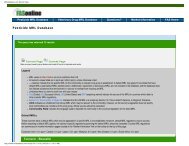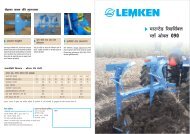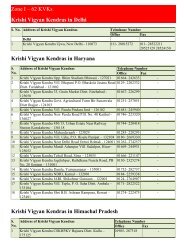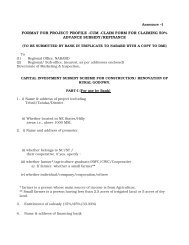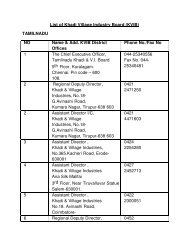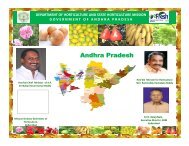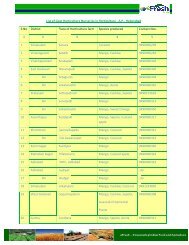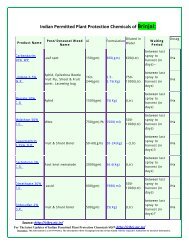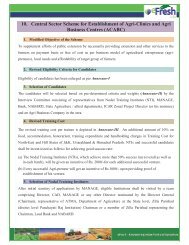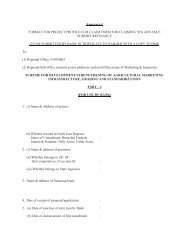Tomato - Efresh India
Tomato - Efresh India
Tomato - Efresh India
You also want an ePaper? Increase the reach of your titles
YUMPU automatically turns print PDFs into web optimized ePapers that Google loves.
eFresh – Empowering <strong>India</strong>n Agriculture<br />
<strong>Tomato</strong><br />
( Lycopersicon esculentum Mill )<br />
<strong>Tomato</strong> is the most important warm season fruit vegetable grown throughout the<br />
world. An exclusive <strong>Tomato</strong> Genetics co-operative located in the University of California,<br />
USA, publishes genetic information on the crop and maintains a large number of<br />
collections, which have already been thoroughly catalogued. It is a typical day-neutral<br />
plant. It is mainly self-pollinated. A certain degree of cross-pollination occurs when the<br />
stigma protrudes outside the level of anthers.<br />
The optimum range of night temperature for fruit set is 15-20 o C. Dehiscence of anthers<br />
takes place 1-2 days after the opening of corolla. <strong>Tomato</strong> is a true diploid with 2 n = 24.<br />
Because of its wider adaptability tomato is grown though out the world either in outdoors<br />
or indoors. China leads in acreage & production of <strong>Tomato</strong> in the world followed by USA.<br />
<strong>India</strong> although has much area as China under <strong>Tomato</strong>, its productivity is only 1/3 of
eFresh – Empowering <strong>India</strong>n Agriculture<br />
Chinese. Cultivated <strong>Tomato</strong> is an annual herb with thick solid stem or spreading vines and<br />
is considered to have originated from Mexico and spread to all the countries. <strong>Tomato</strong> is<br />
known for its outstanding nutritive & medicinal values.<br />
Varieties:<br />
Several cultivars of tomato were developed and recommended by various research<br />
institutes and S.A.Us in <strong>India</strong>. Pusa Ruby, Pusa Early Dwarf, Best of All, Roma, S-120 are<br />
some of the outstanding varieties developed by IARI , New Delhi.<br />
HS102 of HAU, Punjab Chhuhara of PAU are from SAUs. Rashmi, Rupali, Naveen , Rajani,<br />
Vaishali are some of the Hybrids developed by the Indo – American Hybrid Seeds. Today a<br />
number of hybrids developed by the national & multinational seed companies are<br />
available to the farmers. Use of hybrid seeds in <strong>Tomato</strong>, has become more popular than in<br />
other vegetables.<br />
Cultivation:<br />
<strong>Tomato</strong> is cultivated on sandy to heavy clay soils. It needs a well drained soil with capacity<br />
for holding moisture. <strong>Tomato</strong> crop prefers Soils with pH between 6 –7. It is highly<br />
susceptible to frost. High temperatures and humidity favours foliar diseases. <strong>Tomato</strong> can<br />
be grown at temperatures ranging between 15-35 o C. About 150 g seed is required to<br />
raise nursery for transplanting an acre. In the case of hybrid seed 60g are found adequate<br />
to raise the crop in an acre. The seedlings are raised on nursery beds of 40 m 2 for planting<br />
an acre.<br />
The main field for production is prepared by plowing 3-4 times, leveling the land and<br />
making ridges & furrows to facilitate flow irrigation and drainage. Before the final plowing<br />
3-4 tons of well decomposed farm yard manure and 200 kg of Single Super Phosphate is<br />
applied per acre and incorporated into the soil before making the ridges.<br />
Seedlings are taken out from the nursery in the morning and kept in shade and<br />
transplanted in the evening on the sides of the ridges and irrigated immediately. The roots<br />
of the seedlings before transplanting are dipped in solution containing PSB and the tops in<br />
the solution containing a pesticide and a fungicide. The seedlings are transplanted without<br />
bending the tap root.
eFresh – Empowering <strong>India</strong>n Agriculture<br />
Irrigation & Manuring :<br />
<strong>Tomato</strong> requires ample moisture for growth & fruiting. Water stress leads to stunted<br />
growth and dropping of flowers. 50 kg N, 40 Kg P & K per acre are adequate for a normal<br />
crop. P& Part of K applied at the time of planting over a basal application of 5 tonnes FYM<br />
/ acre. N is applied in 3 split does during growth, flowering and fruiting along with K. Use<br />
of micro nutrients especially Boran, Zinc and Manganese helped in increasing plant vigour<br />
and yields in some situations. <strong>Tomato</strong> trained on trellises produce more marketable fruits<br />
compared to unsupported crop as it touches ground resulting in spoilage of fruits and<br />
fungal infections. Inter cultural operations in <strong>Tomato</strong> should be shallow to avoid damage<br />
to roots which remain near the top soil.<br />
Fruit set in tomato is a common problem due to low and high temperatures. Below 13 o C<br />
and above 38 o C fruit set in cultivated tomatoes is hindered. In such situation application of<br />
2, 4- D at 1-2 PPM with 1% urea as whole plant sprays on the crop increases fruit set.<br />
Spraying water on the plants in the evening during summer increases fruit set by keeping<br />
the stigma moist for pollen growth.<br />
Harvesting:<br />
Stages of maturity for harvesting depends upon the specific need.For long distance<br />
marketing fruits are harvested when they are mature firm and greenish yellow. For<br />
processing and local markets, fruits are harvested when they are fully ripe. Normally<br />
<strong>Tomato</strong>es are ready for harvest after 75 to 90 days of planting and continue to give yields<br />
for another 60 days in the case of indeterminate types and 30 days in the case<br />
determinate types. For mechanical harvesting, “once over harvest” types are preferred.<br />
Quality Parameters:<br />
The BSI grades of <strong>Tomato</strong> are Super A1, Super, Fancy and Commercial depending upon the<br />
size, colour and glossiness of the fruits. Fruits meant for processing should have high TSS<br />
and colour index. For canned tomatoes the fruit should have higher pectin content and<br />
firmness and easy peeling skin. Green shoulders, wider stalk ends and cracking are<br />
undesirable for both processing and fresh market. Yield varies from 6- 10 tonnes on<br />
average per acre with straight varieties and 10 to 12 tonnes with hybrids with staking.<br />
Under controlled conditions in poly houses tomatoes yield up to 40 tonnes per acre per<br />
crop.
eFresh – Empowering <strong>India</strong>n Agriculture<br />
Seed Production:<br />
Although a self pollinated crop, considerable cross pollination occurs due to floral<br />
structure. Hence an isolation distance of 50-100 m is desirable depending on the varieties.<br />
Seeds are extracted from ripe fruits through fermentation or Acid/ Alkali methods. The<br />
seed yield varies from 0.2 – 0.8 % of the fruit weight depending on the varieties. Hybrid<br />
seed production in <strong>Tomato</strong> is accomplished through emasculation & hand pollination,<br />
male stability, selective gametocides etc..,<br />
Crop Protection:<br />
Physiological disorders like Blossom End Rot, Fruit Cracking, Sun Scald, Cat Face, and<br />
Puffiness are common in some varieties of tomato. They can be corrected through<br />
regulation of soil moisture, providing shade, application of Boran etc...<br />
Major pest problems in tomato are leaf curl and other viruses, root knot nematodes, wilt<br />
caused by soil pathogens, fruit borers and sucking insects. They can be controlled through<br />
appropriate IPM practices.



